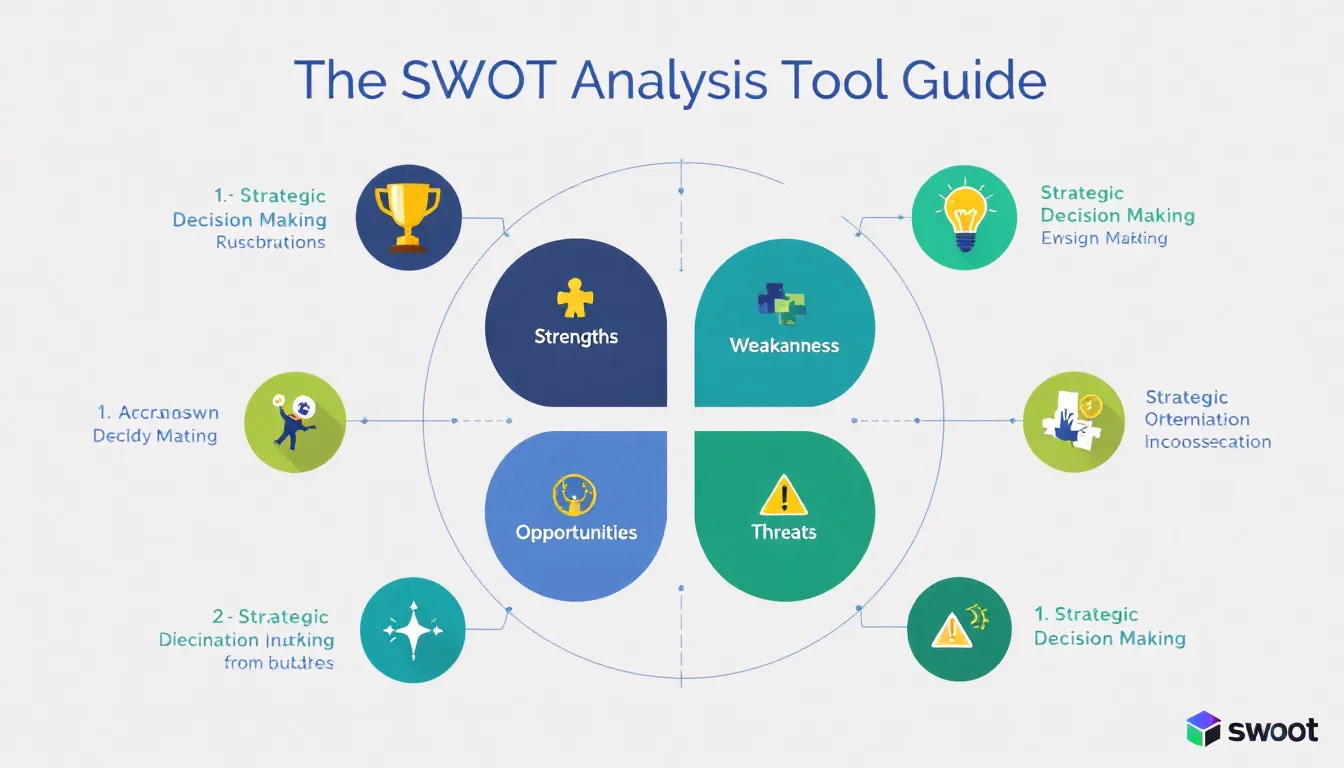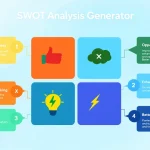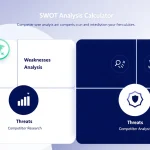Is this tool helpful?
How to Use the SWOT Analysis Tool Effectively
Follow these steps to conduct a comprehensive SWOT analysis for any brand:
- Brand Name: Enter the complete name of the brand you want to analyze. For example: “Spotify” or “McDonald’s”
- Industry/Sector: Specify the primary industry. Example inputs: “Digital Streaming Services” or “Quick Service Restaurants”
- Brand Description: Provide detailed information about the brand’s current market position, products, and services. Include relevant details about market share, recent developments, and unique selling propositions
- Competitors: List major competitors in the market. While optional, this information enhances the analysis quality
- Target Audience: Define the brand’s primary consumer segments and their characteristics
Understanding SWOT Analysis Tool
The SWOT Analysis Tool is a strategic planning instrument that helps businesses evaluate their competitive position by identifying internal strengths and weaknesses alongside external opportunities and threats. This digital tool transforms raw business data into actionable insights, facilitating informed decision-making and strategic planning.
Core Components of SWOT Analysis
- Strengths: Internal positive attributes and resources
- Weaknesses: Internal limitations and challenges
- Opportunities: External favorable factors
- Threats: External challenges and potential risks
Benefits of Using the SWOT Analysis Tool
Strategic Decision Making
The tool provides a structured framework for evaluating business positions, enabling better strategic decisions through:
- Comprehensive situation analysis
- Clear visualization of competitive advantages
- Identification of improvement areas
- Risk assessment and mitigation planning
Time and Resource Optimization
By automating the analysis process, the tool offers:
- Reduced analysis time
- Standardized evaluation criteria
- Consistent reporting format
- Easy sharing and collaboration capabilities
Enhanced Market Understanding
Users gain deeper insights into:
- Market positioning
- Competitive landscape
- Growth opportunities
- Potential market threats
Addressing Business Needs Through SWOT Analysis
Strategic Planning Support
The tool helps businesses develop robust strategies by:
- Identifying core competencies
- Highlighting areas requiring improvement
- Revealing market opportunities
- Anticipating competitive challenges
Performance Improvement
Organizations can enhance their performance through:
- Gap analysis
- Resource allocation optimization
- Risk management
- Opportunity prioritization
Practical Applications and Examples
Example 1: Technology Startup
Consider a mobile app development startup:
- Strengths: Innovative technology, skilled development team
- Weaknesses: Limited marketing budget, small customer base
- Opportunities: Growing mobile app market, emerging technologies
- Threats: Intense competition, rapid technological changes
Example 2: Retail Chain
Analysis of a regional retail chain:
- Strengths: Strong local presence, loyal customer base
- Weaknesses: Limited online presence, outdated inventory system
- Opportunities: E-commerce expansion, personalized shopping experiences
- Threats: Online competitors, changing consumer preferences
Implementation Strategies
Data Collection Best Practices
To maximize the tool’s effectiveness:
- Gather comprehensive market data
- Include multiple stakeholder perspectives
- Update analysis regularly
- Validate findings with industry experts
Action Planning
Transform analysis into action through:
- Priority-based implementation
- Resource allocation planning
- Timeline development
- Progress monitoring systems
Frequently Asked Questions
How often should I conduct a SWOT analysis?
Conduct SWOT analysis quarterly for dynamic markets and semi-annually for stable industries. Additional analysis may be needed during significant market changes or business transformations.
Can I use this tool for personal development?
Yes, the SWOT analysis tool can be adapted for personal career planning and professional development strategies.
What makes a SWOT analysis effective?
Effective SWOT analysis requires honest evaluation, comprehensive data collection, and objective assessment of internal and external factors.
How can I maximize the benefits of SWOT analysis?
To maximize benefits:
- Involve key stakeholders in the analysis process
- Use specific, measurable criteria
- Focus on actionable insights
- Regularly review and update the analysis
Should I share SWOT analysis results with my team?
Yes, sharing results promotes transparency, alignment, and collective problem-solving within the organization.
How do I prioritize actions based on SWOT analysis?
Prioritize actions by:
- Impact on business objectives
- Resource requirements
- Implementation timeline
- Risk level
Important Disclaimer
The calculations, results, and content provided by our tools are not guaranteed to be accurate, complete, or reliable. Users are responsible for verifying and interpreting the results. Our content and tools may contain errors, biases, or inconsistencies. We reserve the right to save inputs and outputs from our tools for the purposes of error debugging, bias identification, and performance improvement. External companies providing AI models used in our tools may also save and process data in accordance with their own policies. By using our tools, you consent to this data collection and processing. We reserve the right to limit the usage of our tools based on current usability factors. By using our tools, you acknowledge that you have read, understood, and agreed to this disclaimer. You accept the inherent risks and limitations associated with the use of our tools and services.







